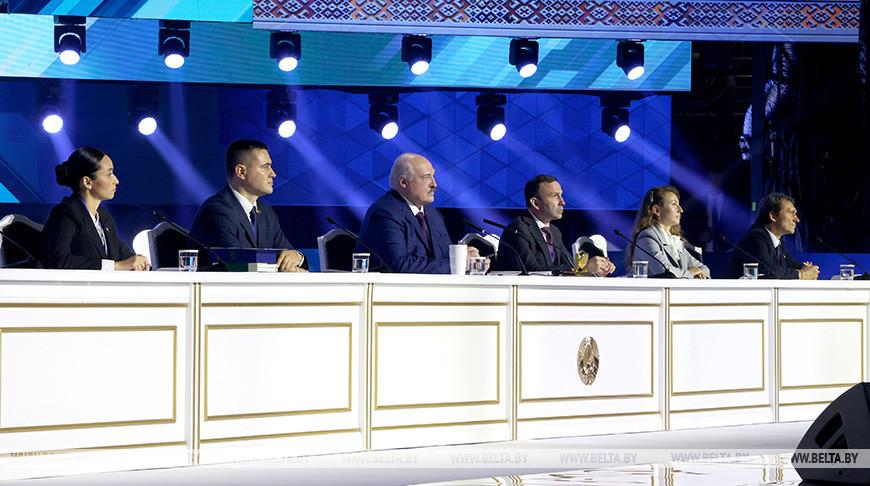This page has been translated automatically and has not yet been verified by experts.
general information
The Great Patriotic War (1941-1945) became one of the most large-scale and tragic events in the history of Belarus. The memory of its events, the heroic exploits of Belarusians at the front and selfless work in the rear, grief over the enormous losses that Belarus suffered during the war, spiritually unites our modern society.
Our land was the first to take the blow of Nazi Germany and managed to give a worthy rebuff to the invaders, showing the whole world an example of courage, fearlessness and heroism. Residents of Belarus, together with all the peoples of the Soviet Union, made a huge contribution to the common cause of Victory over fascism.
In 2024, it will be 80 years since the liberation of our native Belarus during Operation Bagration.
Useful sources
Chronicle of the liberation of Belarus day by day .
Eastern rampart
The events began in August 1943, when the Eastern Wall defensive line was built on the Eastern Front after the defeat of the Wehrmacht at the Kursk Bulge. In Belarus, defensive structures ran along the line Vitebsk – Orsha – Sozh River – Dnieper River. On September 23, 1943, the first liberated Belarusian settlement was the urban village of Komarin . Subsequently, from September to mid-October 1943, the Red Army took control of Khotimsk, Terekhovka, Klimovichi, Kostyukovichi, Mstislavl, Vetka, Krichev, Svetilovichi, Krasnopolye, Cherikov, Dribin, Bragin, Liozno, Dobrush. Further to the west, the fortification infrastructure of the Eastern Wall began.

Loevsky bridgehead
The next stage in the liberation of Belarus from the Nazi invaders during the Great Patriotic War was the Battle of the Dnieper, which began on October 15, 1943 in the Loevsky district of the Gomel region. The crossing of the Dnieper in this place was called the “Loyev bridgehead” and occurred during the all-front operation of the Red Army to reach the Dnieper.

The Battle of Loev is considered one of the significant battles of the Great Patriotic War, held in the area of operation of the Central Front of the Red Army under the command of Army General K. K. Rokossovsky by the forces of the 65th Army under the leadership of Colonel General P. I. Batova. More than three hundred Heroes of the Soviet Union showed themselves in crossing the Dnieper near Loev.
In October 1943, the Central Front of the Red Army, by decree of the Supreme Commander-in-Chief of the Armed Forces of the USSR I. V. Stalin was renamed Belorussian. Thus, the way was opened for the liberation of the southern Belarusian lands from the occupiers in the Gomel direction.

Partisan regions and rail war
The partisan formations were the first to liberate the territory of Belarus from the Nazis. The partisan movement in Belarus during the Great Patriotic War was the most massive in Europe. The uniqueness of this movement was symbolically reflected in the only Partisan parade on July 16, 1944 in Minsk shortly after the liberation of the capital of the BSSR, in which about 30 thousand people's avengers took part, fighting the enemy in years of war.

The partisan struggle in Belarus can be called outstanding by the number of partisan regions – territories in the rear of the Nazi occupiers, which were liberated and held by the partisans for a long time until the arrival of the Red Army.

During the Great Patriotic War, five partisan regions were created on Belarusian soil: Oktyabrsky, Lyubansky, Klichevsky, Surazhsky (“Surazh Gate”), Vadinsky. Of particular importance among them was the creation in 1942 of the so-called. “Surazh Gate” – a 40-kilometer gap in the front line at the junction of enemy army groups “North” and “Center” between the cities of Velizh and Usvyaty.

Here, during the fighting, part of the Surazhsky district of the Vitebsk region was liberated. This victory was of great importance for maintaining the morale of the people, since it was the first Belarusian territory liberated from Nazi troops. The “Surazh Gate” played an important role in establishing the relationship between the Belarusian partisan formations and the Soviet command. Many outstanding leaders of the BSSR were participants in the partisan movement, for example, P. K. Ponomarenko, K. T. Mazurov and P. M. Masherov.

“Rail War” is the largest and most unprecedented mass guerrilla operation during the Great Patriotic War. It was the result of planned interaction and coordination between Soviet partisan detachments and the central, republican and regional headquarters of the partisan movement at the Headquarters of the Supreme Commander-in-Chief of the Armed Forces of the USSR. The purpose of the operation was to destroy the enemy's railway communications by detonation with a simultaneous massive strike. The “Rail War” took place in the occupied territory of the RSFSR, the BSSR and part of the Ukrainian SSR and had three peaks of activity: in August 1943 as assistance to the Red Army partisans in the Battle of Kursk, in October 1943 as assistance in the battle for the Dnieper (Operation “Concert”) and in June-August 1944 as assistance in Operation Bagration.
Operation Bagration
The complete liberation of the territory of Belarus during the Great Patriotic War was carried out as a result of the Belarusian strategic offensive operation codenamed “Bagration”, which took place from June 23 to August 29, 1944. To To crush Army Group Center of the German Wehrmacht, reinforced by the Eastern defensive rampart, it took the combined efforts of the four fronts of the Red Army, symbols of which today are the four bayonets of the Mound of Glory memorial complex, erected near Minsk. A fierce head-on clash of such huge military groups, unprecedented in history, could not do without heavy losses on one side and the other. The Belarusian strategic offensive operation Bagration was one of the bloodiest battles in human history. It also became an outstanding example of Soviet military art, which is still studied by cadets of higher military educational institutions around the world.

During Operation Bagration, impressive results were achieved. The 1st Baltic, 3rd, 2nd and 1st Belorussian Fronts in the period from June 23 to August 29, 1944, having launched an offensive in a strip up to 1100 km wide and to a depth of 600 km, completed the complete liberation of the BSSR, most of Lithuania, part Latvia and Ukraine, transferred the fighting to the territory of Poland and reached the borders of East Prussia.
They defeated one of the most powerful enemy groups on the Soviet-German front – Army Group Center, destroying 17 divisions and three brigades. Another 50 divisions lost more than half of their strength. To make up for the losses incurred and stabilize the situation in the central sector of the Eastern Front, the Wehrmacht command transferred 46 divisions and four brigades here from other directions, weakening their groups deployed against the Anglo-American troops in France.

Outstanding results in Operation Bagration were made possible thanks to the high offensive impulse, patriotism, courage and heroism of the Soviet troops. In July-August 1944 alone, more than 402 thousand soldiers and officers of the Red Army, participants in the Belarusian strategic offensive operation, were awarded orders and medals of the USSR, and more than 600 formations and units were awarded honorary names of the cities of Belarus, Ukraine, Lithuania and Poland that they liberated .
Source: 80 years of liberation of Belarus, bsuir.by .
Prepared by the press service and the department of humanities of the BSUIR.

